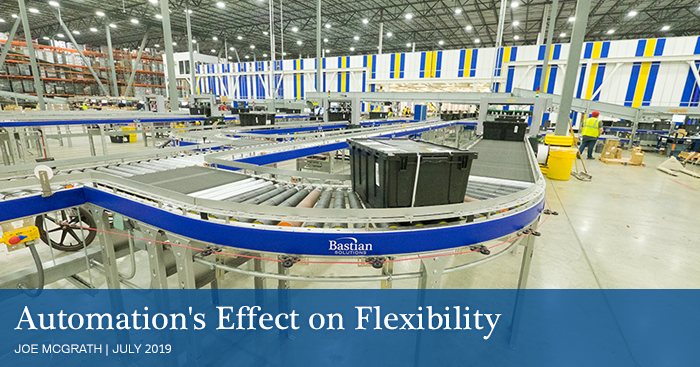
Automation's Effect on Flexibility
Joe McGrath | 31 July 2019
Automation can improve safety, quality, and productivity in one fell swoop. It can make your business more competitive and can even be a powerful marketing tool, like Amazon’s robots all over YouTube.
However, when considering an automated solution, the downsides can’t be overlooked. One of these potential downsides is flexibility. It is important to understand the impact automation will have on the flexibility of your operation, as well as understand how important this flexibility is to the mission of your operation.
The relationship between technology and flexibility
As a thought experiment, consider the 3 following scenarios for a pallet-level warehouse:
- There is nothing more flexible than a wide-open warehouse; you can do anything you want but will likely have a lot of wasted space overhead and long drive times.
- High-bay racking locks down our footprint a bit, but otherwise stores what you want. You can get some pretty good storage density, and you won’t have to dig in bulk bays anymore to retrieve buried loads.
- This ASRS is really fast, the storage density is amazing, and is ultra labor efficient, but can only perform a specified process and the inputs have to be dead on.
3 different levels of technology – floor storage, racking, and ASRS. Each of them has their own place on the flexibility spectrum. At the risk of oversimplifying, the number of options a management team has are generally reduced as the level of automation increases.
Cost and complexity vs. flexibility
We’ve established that the equipment you put into your operation has an impact on how flexible your operation will be; that’s not so bad. Unfortunately, there is another major impact to flexibility that comes with automating a facility, and it has to do with the investment that is associated with the project – both financial and human.
Here are three examples of how the capital investment itself impacts an operation’s flexibility:
- Don’t screw this up: There is a much bigger price to failure with automation vs a simple MHE-based picking process. As the cost to try an iteration of a new process increases, a team will start to lose their “sandbox” that would allow them to try as many sequential iterations needed to dial a process in. For large investment projects, you pretty much have to get it right on the first shot. At Bastian Solutions Consulting, we utilize best practices and simulations to lessen the impact of this issue.
- These things take time: To actually make the investment into automation, your team will have to go through capital approvals, purchasing processes, delivery installation, testing, software integration, and the list goes on. This is a vastly different situation when comparing to a low or no capital project where you have the ability to implement a good idea within the day. Often, the best-case scenario for automated solutions sounds like “I think we might be able to squeeze it in next quarter, IF we really focus on it”.
- That’s a great idea but…: Because of the nature of automation, it is increasingly difficult to incorporate all of the little tweaks and process improvement initiatives that users find throughout the day working the process. Sure, you could work some in, but often some great ideas are left on the table because it costs too much to make the automation or equipment work harmoniously (change orders, am I right?!).
Finding the right balance
- Automation and flexibility don’t have a linear relationship. Automation can be planned such that the inherent flexibility of the solution is maximized – but you have to plan it that way! Think traditional robot cell vs a collaborative robot.
- Automation is a spectrum. Not only can you have different levels of automation for one process (Pallet jack, wire guided MHE, ASRS), but you can also automate some things and not others. The inherent flexibility can be found in seemingly unexpected places (think a full-scale WMS with pickers on pallet jacks). There is a lot of opportunity for the physical process but the software maybe less so.
- Returns on your investment: The goal of a business is to make money. This probably goes without saying, but the return on your investment from automating is heavily influenced by two factors; the return and the investment. A creative engineer would approach this by finding a less expensive type of automation to get the same return, whereas a competitive operations manager would squeeze every ounce of return out of a given investment. Looking at only half the equation limits the tools available to you.
When considering the unique challenges of an operation, and what type of solution or automation is best, it’s important to look at the entire impact each option has – including on flexibility. What works for one company may not be the be suitable for another in the same market. Whatever challenges you have, Bastian Solutions has a lot of talent with operations and engineering experience that can guide clients like you towards finding the optimum solutions to your challenges.
Joe is a Consulting Engineer with Bastian Consulting based in Indianapolis, Indiana. He has and 6 Sigma Black Belt, a Supply Chain Management degree from Iowa State University and an MBA from Purdue Krannert School of Management. Joe has 13 years of operations management, industrial engineering and project management experience.”
Comments
No comments have been posted to this Blog Post
Leave a Reply
Your email address will not be published.
Comment
Thank you for your comment.